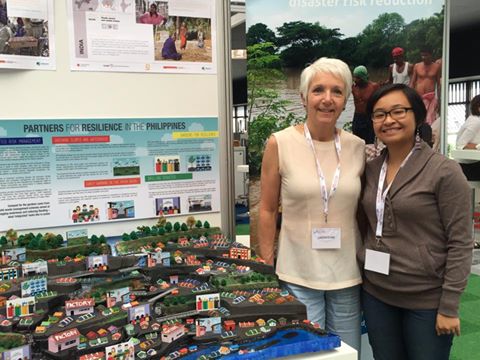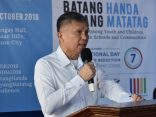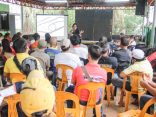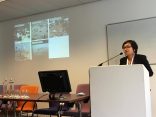Potrero’s risk management milestones receive commendations from international community
Rotterdam, Netherlands – Climate change adaptation and disaster risk reduction scholars and practitioners, policy makers and business people from all over the globe applauded the milestones of Barangay Potrero, Malabon City in integrated risk management during the biennial conference dubbed as Adaptation Futures 2016 in Rotterdam, The Netherlands on May 11 – 13, 2016.
After winning the second place of ‘Gawad Kalasag’ award last year in the National Capital Region (NCR), the lessons and experience of the village in implementing integrated risk management (IRM) was presented to a global conference through Assistance and Cooperation for Community Resilience and Development, Inc. (ACCORD).
ACCORD is one of the local implementer of Partners for Resilience in the Philippines.
After the presentation of ACCORD, Tsuyoshi Inoue, researcher of the Societal Risk Consulting Group, said he admires how the IRM implementation in Potrero includes the community in making decisions.
IRM is a tool used to deeply understand how problems of vulnerability, climate change, and ecosystem degradation are interconnected and exacerbate each other. It also helps the community develop integrated solutions that combine disaster risk reduction, climate change adaptation and ecosystem management and restoration.
Some of the participants described the gains of Potrero as “moving” because of the involvement of the community in IRM.
Erica Bucog, project officer and the representative of ACCORD to the conference, said “IRM sees the most vulnerable people in the community as partners in managing risks rather than risk drivers.
When asked by the participants about the scalability of the IRM approach, Bucog answered that it is the government who bears the primary responsibility of scaling up the IRM. However, it is the role of the civil society organizations to help strengthen the capacity of the government in mainstreaming IRM.
Apart from that, she mentioned that empowering leaders to become champions in the government and the community increases the network of IRM allies.
CARE Nederland’s representative, Reinier van Hoffen, asked if the organization was able to engage the academic sector in implementing IRM.
Bucog replied that through the engagement of academic institutions they are now helping the organization through their small-scale mitigation activities. Engaging the academic community could also enrich the IRM methodology because of the academes’ expertise and knowledge.
Around 30 members of different organizations around the globe listened intently to the IRM experience in Potrero.
Potrero’s IRM milestones
Ecosystem degradation breeds more disasters and reduces resilience while it contributes to climate change abnormalities. On the other hand, climate change increases the frequency and intensity of natural disasters and exacerbates ecosystem degradation. To address the problem, the people of Barangay Potrero have learned to incorporate climate change and ecosystem factors in their risk assessment tools in order to develop a comprehensive risk reduction strategy.
“For example, from using historical information, they are now also considering weather and seasonal forecasts and climate projections in their assessments. They have also learned to look at how actions that degrade the quality of our ecosystem, from destroying forests, to erecting structures in waterways, and dumping household and industrial waste, contribute to increasing risks,” Bucog said.
Barangay Potrero also developed a contingency plan from the risk assessments. To test the effectivity of the contingency plans, mainly the early warning system and the evacuation plan, the community conducted successful evacuation drills.
The whole Tullahan River was also considered in Potrero’s risk management practice. The village, due to their understanding about IRM, knows that they need to consider the wider landscape to have an effective risk management strategy. They understand that they shared common problems and solutions with other communities surrounding the river basin.
“Through reviving the natural ecosystem we are making the whole landscape resilient,” Bucog said.
The community participated in reforestation activities at the slopes of La Mesa watershed to control soil erosion, sedimentation, and siltation of waterways and to help preserve water supplies for the whole region.
The need of Potrero to develop an effective early warning system led to dialogues with other cities and villages along the river basin. The community is aware that they need to collaborate with five cities and 398 urban barangays to come up with an effective risk management strategy.
The existing alliance of Malabon, Navotas, Tullahan, Tinajeros, dubbed as MANATUTI Alliance were also influenced by Partners for Resilience (PfR) to pursue IRM from a purely environmental focus.
The dialogues were headed by the Philippine Atmospheric, Geophysical and Astronomical Services Administration (PAGASA) and the Department of Interior and Local Government – National Capital Region (DILG-NCR)
Sindhy Obias, concurrent executive director of ACCORD, said for the Tullahan River Basin, tree planting in 7.5 has. of the La Mesa watershed was conducted, with a guaranteed two-years maintenance from the Bantay Kalikasan program of the ABS-CBN Lingkod Kapamilya Foundation. The reforestation is also aimed to prevent soil erosion and serve as surface runoff control.
The La Mesa watershed also serves as the main source of fresh water for Metro Manila, while its forests absorbs carbon emissions that cause global warming and climate change.
“This importantly underscores the application of the landscape approach where protecting the watershed at the upstream location of the river basin is recognized to have benefits to the communities located downstream. These communities experience the major flooding,” Obias said.




